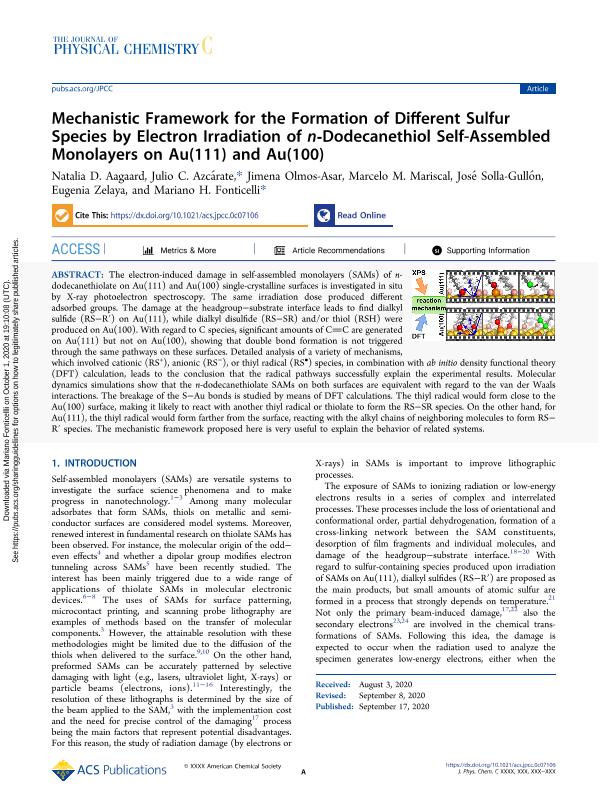Artículo
Mechanistic framework for the formation of different sulfur species by electron irradiation of n -Dodecanethiol Self-Assembled monolayers on Au(111) and Au(100)
Aagaard, Natalia Desiré ; Azcárate, Julio César
; Azcárate, Julio César ; Olmos Asar, Jimena Anahí
; Olmos Asar, Jimena Anahí ; Mariscal, Marcelo
; Mariscal, Marcelo ; Solla-Gullón, José; Zelaya, Maria Eugenia
; Solla-Gullón, José; Zelaya, Maria Eugenia ; Fonticelli, Mariano Hernan
; Fonticelli, Mariano Hernan
 ; Azcárate, Julio César
; Azcárate, Julio César ; Olmos Asar, Jimena Anahí
; Olmos Asar, Jimena Anahí ; Mariscal, Marcelo
; Mariscal, Marcelo ; Solla-Gullón, José; Zelaya, Maria Eugenia
; Solla-Gullón, José; Zelaya, Maria Eugenia ; Fonticelli, Mariano Hernan
; Fonticelli, Mariano Hernan
Fecha de publicación:
10/2020
Editorial:
American Chemical Society
Revista:
Journal of Physical Chemistry C
ISSN:
1932-7447
e-ISSN:
1932-7455
Idioma:
Inglés
Tipo de recurso:
Artículo publicado
Clasificación temática:
Resumen
The electron-induced damage in self-assembled monolayers (SAMs) of n-dodecanethiolate on Au(111) and Au(100) single-crystalline surfaces is investigated in situ by X-ray photoelectron spectroscopy. The same irradiation dose produced different adsorbed groups. The damage at the headgroup-substrate interface leads to find dialkyl sulfide (RS-R′) on Au(111), while dialkyl disulfide (RS-SR) and/or thiol (RSH) were produced on Au(100). With regard to C species, significant amounts of CC are generated on Au(111) but not on Au(100), showing that double bond formation is not triggered through the same pathways on these surfaces. Detailed analysis of a variety of mechanisms, which involved cationic (RS+), anionic (RS-), or thiyl radical (RS•) species, in combination with ab initio density functional theory (DFT) calculation, leads to the conclusion that the radical pathways successfully explain the experimental results. Molecular dynamics simulations show that the n-dodecanethiolate SAMs on both surfaces are equivalent with regard to the van der Waals interactions. The breakage of the S-Au bonds is studied by means of DFT calculations. The thiyl radical would form close to the Au(100) surface, making it likely to react with another thiyl radical or thiolate to form the RS-SR species. On the other hand, for Au(111), the thiyl radical would form farther from the surface, reacting with the alkyl chains of neighboring molecules to form RS-R′ species. The mechanistic framework proposed here is very useful to explain the behavior of related systems.
Archivos asociados
Licencia
Identificadores
Colecciones
Articulos(INFIQC)
Articulos de INST.DE INVESTIGACIONES EN FISICO- QUIMICA DE CORDOBA
Articulos de INST.DE INVESTIGACIONES EN FISICO- QUIMICA DE CORDOBA
Citación
Aagaard, Natalia Desiré; Azcárate, Julio César; Olmos Asar, Jimena Anahí; Mariscal, Marcelo; Solla-Gullón, José; et al.; Mechanistic framework for the formation of different sulfur species by electron irradiation of n -Dodecanethiol Self-Assembled monolayers on Au(111) and Au(100); American Chemical Society; Journal of Physical Chemistry C; 124; 41; 10-2020; 22591-22600
Compartir
Altmétricas



